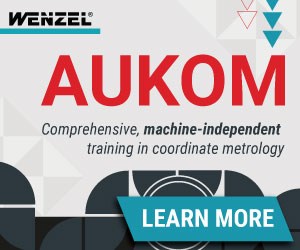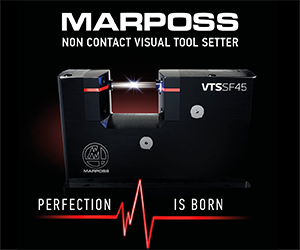Revving Up The CMM
High speed, five-axis scanning promises to give throughput on coordinate measuring machines a big boost. Entire manufacturing strategies may be up for rethinking as a result.
An online video shows the probe rotating in space, spiraling in a bore and sweeping across a surface.
It’s all about throughput—how quickly a workpiece moves through a process, and how quickly a part moves through the factory from start to finish. Factory throughput, of course, is ultimately linked to process throughput. One process that is often a bottleneck for manufacturers of complex, high-value parts is gathering metrology data. Engine blocks and jet engine turbine blades, for example, require large numbers of data points for process control and quality verification.
Gathering this data on a coordinate measuring machine (CMM) can be too slow to keep up with CNC machine tools. By the time metrology data catches up with events on the shop floor, it may be too late to prevent the production of out-of-spec parts. In short, the low throughput of the CMM holds back the rest of the plant.
Renishaw, the U.K. company that invented the trigger-touch probe for CMMs and machine tools (U.S. headquarters: Hoffman Estates, Illinois), has developed technology for high speed scanning of complex workpieces on computer-driven CMMs. According to the company, this development raises CMM productivity by a magnitude comparable to that achieved by the introduction of the touch-trigger probe more than 30 years ago. CMM scanning times as high as 500 mm per second—50 times faster than conventional practice—are now possible, the company says.
High speed scanning transforms measurement, greatly reducing cycle times while simultaneously increasing the number of points that can be captured. Gathering more data in less time will allow manufacturers to measure more features, inspect more parts, meet tighter part specifications and keep processes under tighter control.
A number of major corporations that make jet engines, commercial aircraft and off-road construction equipment are already anticipating how they can use this technology to revamp production strategies. Ultimately, these strategies are expected to improve the overall productivity of CNC machine tools and other production equipment.
The State Of CMM Scanning
With scanning, a CMM can collect many more data points than a trigger-touch probe moving from point to point. When scanning, the tip of the probe stays in constant contact with the surface of the workpiece. The changing position of the probe tip is recorded at regular intervals to capture a series of data points. These additional data points yield a digital representation of the part feature that is more complete than that derived from point-to-point probing. For example, scanning can capture the irregular shape of a contoured surface in a mold cavity or the subtly twisted curve of a blade on an impeller rotor. Likewise, the roundness and straightness of a critical bore can be determined throughout its full length.
Scanning on a CMM, however, faces certain limitations that affect measurement throughput. Most CMMs are configured for three-axis motion. The mass of the machine’s structure creates inertia that causes dynamic errors when moving the CMM at a high rate of acceleration and deceleration. To avoid these inertial errors, scanning speed must be limited. (Most scanning is done between 5 mm per second and 15 mm per second.) Similarly, three-axis motion limits the maneuverability of the probe stylus. It may not be able to reach some workpiece surfaces, such as those within a bladed disk.
Overcoming these and many other limitations was the challenge that Renishaw had to meet in order to achieve significantly higher levels of scanning CMM throughput. Doing so required the company to create and integrate innovations on several fronts. These include a five-axis machine control system; a probe head with self-contained rotating and swiveling action; a stylus with an internal laser position sensing; and an open software interface that will facilitate implementing high speed, five-axis scanning for both the end user and the OEM. According to the company, this achievement represents the longest and most complex development program in its history. It has taken more than 11 years to bring this product to market.
A Convergence Of Enablers
The most conspicuous piece of this new technology is the two-axis Revo probe head. This head, powered by direct-drive brushless motors inside, rotates and swivels in a wrist-like motion. The resemblance of this motion to that of a rotary milling head on a five-axis milling machine is quite striking. In fact, this two-axis head performs most of the work in the five-axis scanning mode.
Some key features and characteristics of this head as listed by the developers include the following:
- Infinite positioning capability. The head has infinite rotation in the vertical axis and swivels 125 degrees in the horizontal axis. This range of motion lets the stylus access difficult-to-reach part features. Complex stylus configurations are not needed. The head can spin continuously without returning to a zero position.
- Low mass. Because this head provides most of the scanning motion, the more massive linear axes of the CMM do not have to travel as far or move as quickly. This greatly reduces the inertia involved in scanning routines and thereby reduces inertial errors.
- High-resolution rotary encoders. Resolving to 0.08 arc seconds, these proprietary encoders are the source of high positioning accuracy in the motion of the head.
Renscan5 is the name of the five-axis control system developed to drive the rotary head and synchronize it with the linear moves of the CMM. The software covers error-mapping routines to compensate for the effects of geometry, temperature and machine dynamics.
The most important capabilities of this drive system include the following:
- Allowing the CMM to move at a constant velocity as measurements are being taken. This eliminates errors related to high acceleration and deceleration rates.
- On-the-fly repositioning of the head and stylus. This reduces delays when moving from part feature to part feature and helps shorten cycle times. Because the head rotates continuously, repositioning can be done by the shortest possible route.
- Data processing at 2,000 points per second. The head is actually capable of collecting data at 6,000 points per second and storing the additional points for off-line processing.
The stylus developed for the system is a hollow tube, which is different from previous designs. A laser beam travels from within the probe body through the tube to a reflector at the stylus tip. The beam’s reflection returns to a “position sensing detector” in the probe body. Unlike a conventional probe stylus that needs to be very stiff, the hollow tube is designed to bend, thereby deflecting the returning laser beam. Movement of the laser spot on the sensor is translated into measurement output by combining it with information about the geometry of the measuring head and probe, and each of the CMM axis readings. This is how the exact position of the stylus tip can be generated.
This stylus design provides important benefits:
- High speed and accuracy can be achieved because the laser beam is not affected by gravity, inertia or temperature.
- Mass is low, complementing the low-mass characteristics of the probe head.
- The probe attains a 1-micron accuracy at 250 mm from the axis of rotation, developers claim.
- A stylus can be as long as 500 mm for extended probe reach.
- The probe is calibrated in one position and does not need to be recalibrated after repositioning.
Finally, the open interface developed for the five-axis scanning system deserves attention. This interface complies with I++DME, a standardized protocol that allows measurement routines written by CMM programming software to drive any complying CMM. Renishaw’s five-axis controller can be interfaced to virtually any CMM, enabling existing CMMs to be readily retrofitted for five-axis scanning.
New Thinking Is Possible; New Possibilities Are Thinkable
Renishaw reports that manufacturers are showing great interest in high speed, five-axis scanning on CMMs. This interest goes well beyond the obvious prospect of easing bottlenecks in part inspection.
Innovative probing routines such as sweep scanning and zigzag edge measurement are possible. The latter is especially important to applications involving jet engine turbine blades because edges are difficult to measure with conventional techniques. Helical scans of automotive cylinder bore IDs will not only speed inspection of these critical engine block features, but they will also provide much more data for better monitoring of cylindricity and other characteristics.
One hundred percent inspection can be extended to more parts. This requirement is spreading among aerospace components. Simply increasing the sample size for production control promises a large payoff. For example, one manufacturer of automotive transmission housings expects to measure three housings per hour instead of three per shift, thus drastically reducing part variation.
In some cases, better and faster process control may allow a move to more aggressive machining parameters. Effective monitoring reduces the risk associated with aggressive techniques.
Other, more radical changes to manufac-turing strategies will come to light as manufacturers explore the capabilities of revved-
up scanning CMMs. Clearly, lifting restraints on CMM throughput is lifting the restraints on bold thinking about how to produce complex, high-value workpieces.
Related Content
Parts and Programs: Setup for Success
Tips for program and work setups that can simplify adjustments and troubleshooting.
Read MoreBallbar Testing Benefits Low-Volume Manufacturing
Thanks to ballbar testing with a Renishaw QC20-W, the Autodesk Technology Centers now have more confidence in their machine tools.
Read MoreHow to Choose the Right Cut Off When Measuring Roughness
Measurement results for surface finishing parameters can vary depending on the filter parameter (Lc), also known as the cutoff.
Read MoreHow to Calibrate Gages and Certify Calibration Programs
Tips for establishing and maintaining a regular gage calibration program.
Read MoreRead Next
The Cut Scene: The Finer Details of Large-Format Machining
Small details and features can have an outsized impact on large parts, such as Barbco’s collapsible utility drill head.
Read More3 Mistakes That Cause CNC Programs to Fail
Despite enhancements to manufacturing technology, there are still issues today that can cause programs to fail. These failures can cause lost time, scrapped parts, damaged machines and even injured operators.
Read MoreObscure CNC Features That Can Help (or Hurt) You
You cannot begin to take advantage of an available feature if you do not know it exists. Conversely, you will not know how to avoid CNC features that may be detrimental to your process.
Read More






.jpg;width=860)

















.png;maxWidth=300;quality=90)
.png;maxWidth=300;quality=90)







